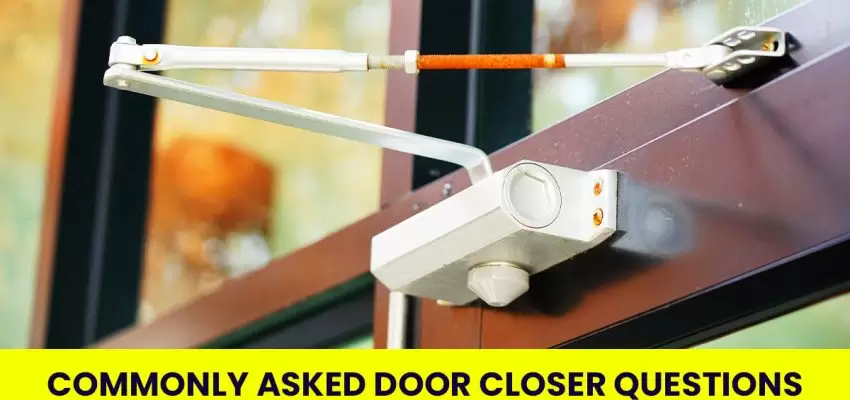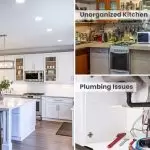For homeowners seeking to bolster safety and functionality, investing in a door closer is a wise move. Our blog delves into the most common queries surrounding door closers, providing insights into their functionality and assisting in the selection of the right type. Explore our comprehensive guide for an informed decision that aligns with your safety and security goals.
Post your Requirement
What is a Door Closer, and How Does it Work?
A door closer is an essential hardware device mounted on doors to ensure automatic closure after being opened. The mechanism employed by door closers is typically hydraulic or spring-based, controlling the door’s closing speed. Hydraulic door closers use fluid resistance to regulate the closing motion, providing a smooth and controlled operation. On the other hand, spring-based door closers store energy in a spring when the door is opened and released it to facilitate closure. The primary purpose of a door closer is to enhance safety and security in various settings. By automatically closing doors, it helps prevent unauthorized access, maintains controlled environments, and contributes to the overall functionality of a space.
Why Are Door Closers Important?
Door closers play a crucial role in maintaining safety and security within a building. Their importance is evident in several key aspects:
- Fire Containment: Door closers are instrumental in containing fires during emergencies. By automatically closing doors, they help restrict the spread of fire, providing valuable time for evacuation and minimizing damage.
- Privacy: Door closers contribute to privacy by ensuring that doors are consistently closed. This is particularly important in settings such as offices, meeting rooms, and bedrooms.
- Noise Control: Beyond security, door closers act as barriers to control noise intrusion. By keeping doors closed, they help create quieter environments, enhancing comfort and focus.
What Are the Main Types of Door Closers?
Door closers come in various types, each designed to meet specific needs and preferences. The two main types are concealed and surface-mounted door closers.
- Concealed Door Closers: Concealed door closers are not visible when the door is closed. They are often preferred for areas with high traffic and where a clean and sleek appearance is desired. Concealed closers can be used on doors that open from one side or both sides.
- Surface-Mounted Door Closers: Surface-mounted door closers are visible on the surface of the door. They come in different variations, including slide-track arm, regular arm surface, parallel arm, and top jamb mounted. Surface-mounted closers are easy to install and maintain, making them a common choice in various industries.
How Do Manual and Automatic Door Closers Differ?
Manual and automatic door closers differ in their mechanisms and modes of operation.
- Manual Door Closers: Manual door closers operate by utilizing a spring mechanism. When the door is opened, the spring stores energy, and upon release, it expends this energy to facilitate door closure. Manual door closers are often referred to as spring, parallel arm, or magnetic door closers. To control the closing speed of manual door closers, oil-filled hydraulic dampers are commonly used. This allows for a more controlled and gradual closing motion, preventing the door from slamming shut.
- Automatic Door Closers: Automatic door closers, as the name suggests, operate through a control mechanism. This control can take the form of a push-button or a motion detector. The door opens and closes automatically based on the signals received from the control mechanism. Automatic door closers often employ proximity detectors to determine when it is safe to close. This is particularly beneficial in high-traffic areas where doors need to open and close frequently without manual intervention.
What Factors Should I Consider When Choosing a Door Closer Size?
Selecting the right size for a door closer is crucial for optimal functionality. Consider the following factors when determining the appropriate size: The size of a door closer is typically categorized from 1 to 6, with each size corresponding to a range of door weights and heights. Consult with the manufacturer or refer to product specifications to match the door closer size to the specific weight and height of the door. Choosing the correct size ensures that the door closer can effectively control the closing motion without exerting unnecessary force or struggling with a door that is too heavy.
What Is the Significance of the Fire Rating in a Door Closer?
The fire rating of a door closer is a critical aspect, especially in the context of building safety and emergencies.
- Fire Containment: The primary significance of the fire rating is its role in fire containment. During a fire outbreak, doors equipped with fire-rated closers help contain the flames and smoke, limiting the spread to other areas of the building.
- Certification for Safety: The fire rating is often accompanied by a metal label or certification that verifies the door closer’s compliance with safety standards. This certification is crucial for ensuring that the door closer is reliable in emergencies.
When purchasing a door closer, checking the fire rating and associated certifications is essential to contribute to the overall fire safety measures of a building.
Can Door Closers Be Used for Both Residential and Commercial Purposes?
Yes, door closers are versatile and come in different grades, making them suitable for both residential and commercial applications.
- Grade 1 Door Closers: These are designed for heavy-duty commercial use. Grade 1 door closers are robust and built to withstand frequent and rigorous operation. They are commonly used in settings such as commercial buildings, schools, and healthcare facilities.
- Grade 2 Door Closers: These are suitable for residential purposes. While not as heavy-duty as Grade 1, Grade 2 door closers are still durable and provide reliable performance for home use. They are often found in residential buildings, apartments, and smaller commercial spaces.
Choosing the right grade depends on the intended application. For commercial settings with high traffic and demanding conditions, Grade 1 door closers are recommended. For homes and lighter commercial use, Grade 2 door closers offer a suitable balance of performance and cost-effectiveness.
Are There Specific Finishes Available for Door Closers?
Yes, door closers are available in a variety of finishes to complement different architectural styles and preferences.
- Stainless Steel: Stainless steel finishes are popular for their modern and sleek appearance. They are resistant to corrosion and offer a clean and contemporary look. Stainless steel door closers are often chosen for commercial and high-end residential applications.
- Brass: Brass finishes provide a classic and timeless aesthetic. While brass may require periodic maintenance to prevent tarnishing, many appreciate its traditional and elegant appeal. Brass door closers are suitable for both residential and commercial settings.
- Bronze: Bronze finishes offer a warm and rustic appearance. They are well-suited for spaces with a more traditional or vintage design. Bronze door closers can add a touch of character to entrances in various settings.
How Do Concealed Door Closers Differ from Surface-Mounted Ones?
Concealed and surface-mounted door closers differ in their visibility, installation, and aesthetic considerations.
Concealed Door Closers:
- Visibility: Concealed door closers are not visible when the door is closed. This makes them an ideal choice for areas where a clean and unobtrusive appearance is desired.
- Installation: Concealed closers are installed within the door or door frame, maintaining a seamless and concealed look. They are often used in high-traffic areas and entrances where aesthetics play a crucial role.
- Aesthetics: The concealed nature of these closers provides a sleek and modern appearance. They are preferred for applications where the focus is on a clean and uninterrupted design.
Surface-Mounted Door Closers:
- Visibility: Surface-mounted door closers are visible on the surface of the door. They come in different variations, including slide-track arm, regular arm surface, parallel-arm, and top jamb mounted.
- Installation: Surface-mounted closers are installed on the surface of the door or door frame. They are relatively easier to install and maintain compared to concealed closers.
- Aesthetics: While visible, surface-mounted closers come in various designs and finishes. They are a practical choice for applications where aesthetics are important, and the closer’s appearance can be coordinated with the overall design.
Investing in a high-quality door closer is a crucial step in enhancing the safety, security, and functionality of your space. Consider the size, type, quality, fire rating, finish, and price when making your purchase. Explore offerings from top brands available online to find the perfect door closer to your needs. Make your home or office a safer and more efficient space with the right door closer today.
Also Read: Comprehensive Buying Guide on Door Handles























Post A Comment